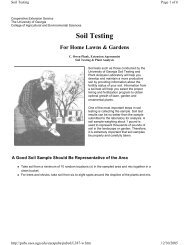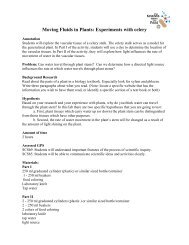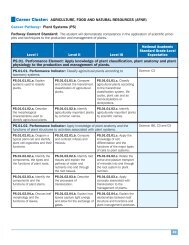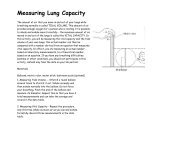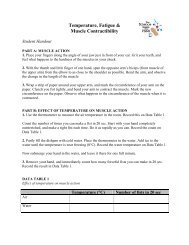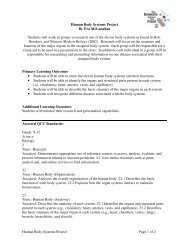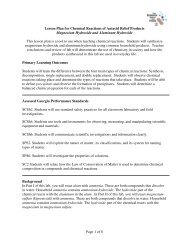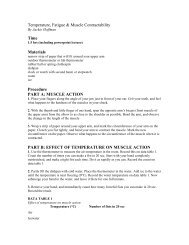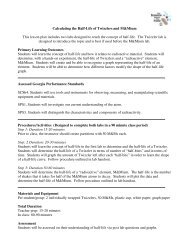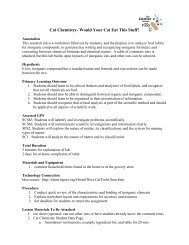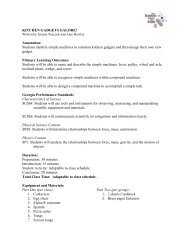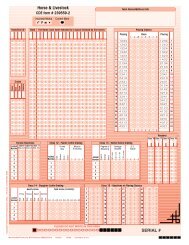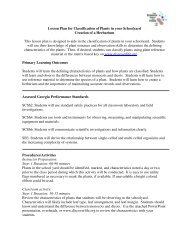Basic Agriculture Science - Georgia Department of Education
Basic Agriculture Science - Georgia Department of Education
Basic Agriculture Science - Georgia Department of Education
Create successful ePaper yourself
Turn your PDF publications into a flip-book with our unique Google optimized e-Paper software.
<strong>Georgia</strong> <strong>Department</strong> <strong>of</strong> <strong>Education</strong><br />
Course Standard 4<br />
AFNR-BAS-4<br />
Recognize how agriculture meets human needs today, in the past, and for the future.<br />
4.1 Explain the three basic human needs and sources for food, clothing, and shelter.<br />
4.2 Define agriculture.<br />
4.3 Identify major agricultural milestones or inventions and analyzes their impact on modern<br />
life and agriculture.<br />
4.4 Describe the eight major branches <strong>of</strong> the agriculture industry.<br />
4.5 Determine <strong>Georgia</strong>’s top 10 agricultural commodities.<br />
4.6 Differentiate between agricultural imports and exports and list examples <strong>of</strong> each.<br />
4.7 Compare and contrast between agricultural products and byproducts and lists examples <strong>of</strong><br />
each.<br />
4.8 Identify the top three agricultural commodities within each region <strong>of</strong> the United States and<br />
the world.<br />
Support <strong>of</strong> CTAE Foundation Course Standards and Common Core GPS and <strong>Georgia</strong><br />
Performance Standards<br />
ELACC9-10SL1: Initiate and participate effectively in a range <strong>of</strong> collaborative discussions (oneon-one,<br />
in groups, and teacher-led) with diverse partners on grades 9–10 topics, texts, and<br />
issues, building on others’ ideas and expressing their own clearly and persuasively.<br />
ELACC9-10SL4: Present information, findings, and supporting evidence clearly, concisely, and<br />
logically such that listeners can follow the line <strong>of</strong> reasoning and the organization, development,<br />
substance, and style are appropriate to purpose, audience, and task.<br />
ELACC9-10SL2: Integrate multiple sources <strong>of</strong> information presented in diverse media or formats<br />
(e.g., visually, quantitatively, orally) evaluating the credibility and accuracy <strong>of</strong> each source.<br />
Course Standard 5<br />
AFNR-BAS-5<br />
Determine and illustrate safety in the agriculture lab and agriculture worksites.<br />
5.1 Identify hazards in agricultural education labs and work sites.<br />
5.2 Select safety equipment and procedures for various agriculture related activities.<br />
5.3 Discuss the importance <strong>of</strong> safety in agricultural occupations.<br />
5.4 Demonstrate safety procedures and appropriate behavior while working in the agriculture<br />
classroom, labs, and/or work sites.<br />
Course Standard 6<br />
AFNR-BAS-6<br />
Describe soil formation and management and assess its relevance to plant/animal<br />
production and natural resources management.<br />
6.1 Describe soil formation and soil composition.<br />
6.2 Differentiate between soil components.<br />
6.3 Explain the importance <strong>of</strong> soil ecosystems.<br />
6.4 Analyze the importance <strong>of</strong> slope, soil texture, erosion, and water movement in determining<br />
land capability and land use.<br />
<strong>Georgia</strong> <strong>Department</strong> <strong>of</strong> <strong>Education</strong><br />
Dr. John D. Barge, State School Superintendent<br />
January 25, 2013 ·Page 3 <strong>of</strong> 9<br />
All Rights Reserved



